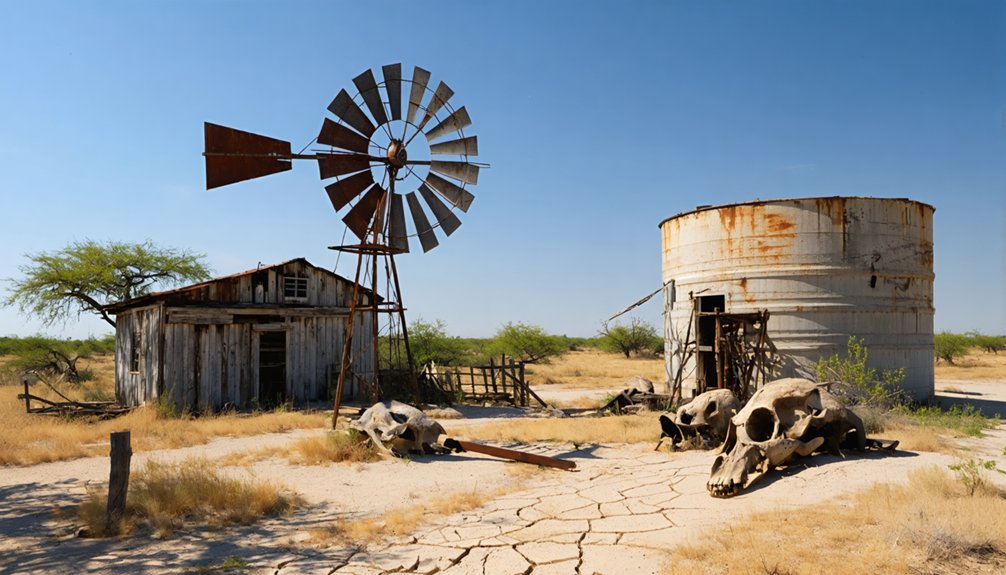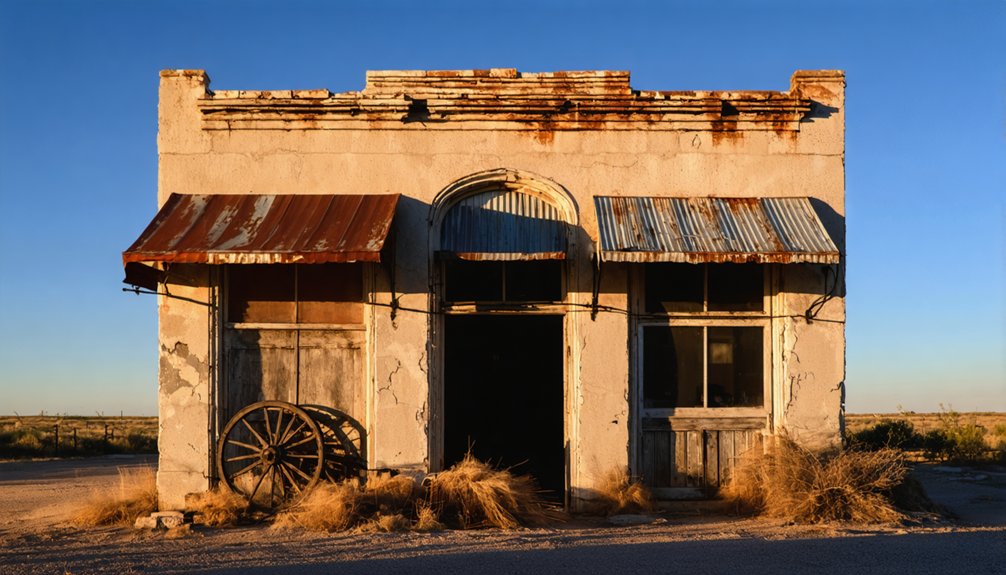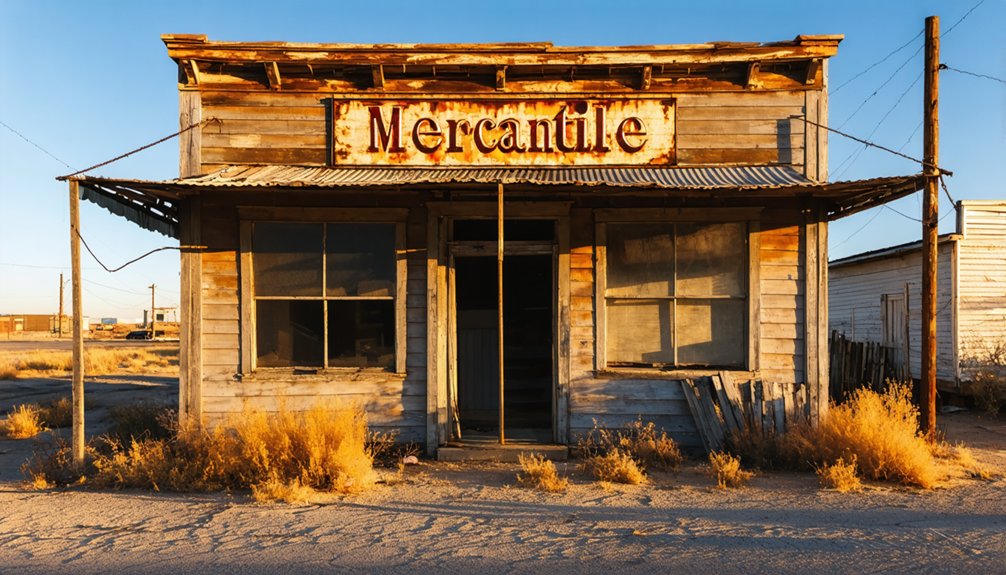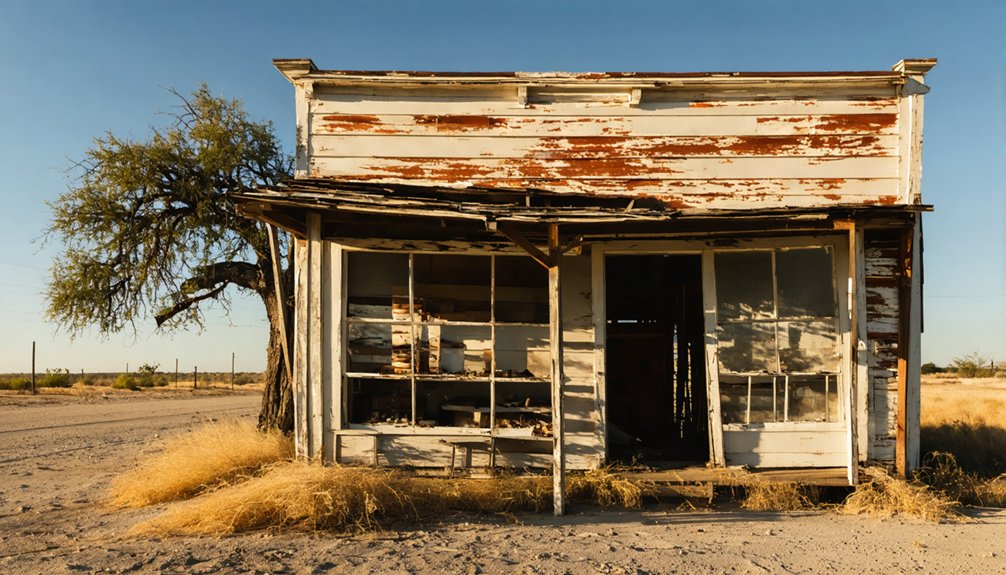You’ll find the ghost town of Los Ojuelos in Webb County, Texas at 27°24′11″N 98°59′47″W, where thirteen stone houses still stand from its frontier days. The settlement, established in 1857 by José María Guerra, grew around crucial springs that supported 400 residents and a 20,000-acre ranch. Texas Rangers under Captain John S. “Rip” Ford protected this strategic outpost along the Laredo-Corpus Christi trade route until its decline began in 1855. These ruins tell a story of water, warfare, and Texas’s wild frontier spirit.
Key Takeaways
- Los Ojuelos was established in 1857 around vital springs, growing to 400 residents before declining when bypassed by the Texas-Mexican railroad.
- Thirteen stone houses remain today, preserving the architectural heritage of this once-thriving frontier settlement in South Texas.
- The community flourished as a strategic outpost along the Laredo-Corpus Christi trade route, protected by Texas Rangers in the 1850s.
- Despite an oil boom in 1921, Los Ojuelos gradually transformed into a ghost town while nearby Mirando City prospered.
- The settlement’s decline exemplifies how railroad bypasses and shifting economic forces could doom frontier communities in early Texas.
Early Frontier Life and Settlement Origins
While indigenous peoples had long utilized the springs as their only reliable water source in this semiarid region, Los Ojuelos’ European settlement history began in 1810 when Eugenio Gutiérrez received a Spanish land grant.
You’ll find that frontier challenges immediately tested the settlers’ resolve, as Native American raids forced Gutiérrez to abandon his initial settlement attempt. His sons faced similar resistance when they tried again in 1835. The Texas Rangers established a presence in 1850 to protect travelers along the Laredo-Corpus Christi route.
It wasn’t until 1857 that settlement resilience finally took hold when José María Guerra, Gutiérrez’s grandson, established a permanent village. Guerra’s innovative approach included building a protective stone enclosure and irrigation systems around the springs.
By 1860, the thriving community had grown to a population of about 400 settlers, drawing residents from throughout the Rio Grande Valley.
A Strategic Outpost in Webb County
Because of its essential location at 27°24′11″N 98°59′47″W near Mirando City in southeastern Webb County, Los Ojuelos became an important strategic outpost along the Laredo-Corpus Christi trade corridor.
Positioned strategically near Mirando City, Los Ojuelos served as a vital outpost connecting the Laredo-Corpus Christi trade routes.
The Texas Rangers established this frontier post in 1850, recognizing how its natural springs could sustain settlement patterns in the semiarid region.
You’ll find that the site’s trade dynamics revolved around protecting merchants and settlers from Native American attacks while maintaining critical commerce routes.
José María Guerra enhanced the outpost’s sustainability in 1857 by building an irrigation system, while protective stone walls and 13 sandstone buildings created a defensive settlement.
Even after the railroad bypassed Los Ojuelos, it remained essential for regional security, later serving as a base to combat tequileros during Prohibition.
The Texas Rangers’ Stronghold
In 1850, you’d have found Texas Rangers stationed at Los Ojuelos under Captain John S. “Rip” Ford, transforming this Webb County outpost into a strategic stronghold for protecting the crucial trade route between Laredo and Corpus Christi.
The Rangers utilized their Colt six-shooters during patrols, having helped develop these reliable firearms through direct field testing and feedback to Samuel Colt. Their presence proved essential in combating frequent Native American raids that threatened settlers and merchants traversing South Texas’s expanding commercial corridor.
Their camp’s location near Los Ojuelos’s natural springs offered both tactical advantages for border defense and reliable water access, which helped support the growing settlement that reached 400 residents by 1860.
Strategic Border Defense Location
Los Ojuelos emerged as a significant Texas Rangers stronghold in 1850 when Captain John S. “Rip” Ford established a strategic camp to defend the important trade route between Laredo and Corpus Christi.
You’ll find this early border patrol outpost was positioned perfectly to control the essential springs and monitor movements across southeastern Webb County’s untamed frontier.
The site’s military strategy emphasized both defense and sustainability. In 1857, José María Guerra fortified the settlement with a stone wall enclosure and thirteen structures built from local white rock.
These buildings featured thick walls designed to collapse outward, protecting those inside. The Rangers’ presence helped stabilize the region by combining frontier law enforcement with guerrilla warfare tactics, effectively reducing raids and securing this significant water source in the semi-arid borderlands. The Rangers’ expertise in horseback shooting and use of Colt Paterson revolvers made them particularly effective in patrolling this remote outpost.
Protecting Trade Routes
The Texas Rangers’ strategic presence at Los Ojuelos expanded beyond mere border defense to become an essential trade route protection operation. Under Captain John S. “Rip” Ford in 1850, they established a stronghold to safeguard the critical economic lifeline between Laredo and Corpus Christi.
You’ll find their trade route management strengthened by:
- Close coordination with the Guerra family’s fortified settlement
- Protection of important spring water resources surrounded by stone walls
- Regular patrols deterring bandits along commerce corridors
- Support of 20,000-acre ranching operations supplying frontier communities
Working alongside local settlers, the Rangers maintained security for 45 to 60-day trade expeditions moving cattle, wool, and horses to coastal markets.
This joint effort transformed Los Ojuelos into a thriving hub that guaranteed uninterrupted commerce flow through Texas’ dangerous frontier.
Fighting Indian Raids
While frontier settlements across South Texas struggled against persistent Indian raids, Los Ojuelos emerged as a critical Rangers’ stronghold in 1850 under Captain John S. “Rip” Ford’s command.
You’d find Rangers executing swift patrols to intercept Comanche raiding parties that targeted essential water springs and livestock along the Laredo-Corpus Christi trade route.
In response to raider tactics, José María Guerra fortified Los Ojuelos in 1857 with thick stone walls designed to fall outward if attacked.
The compound’s 13 buildings, chapel, and irrigation system demonstrated settler resilience against repeated assaults.
The Rangers worked closely with local families like the Guerras, creating an effective defense network that gradually reduced raid intensity.
Water Resources and Survival

You’ll find Los Ojuelos’ very existence centered on its namesake natural springs, which served as the only reliable water source in this semiarid region between the Nueces River and Rio Grande.
These “little eyes” springs drew indigenous peoples to camp nearby, then attracted permanent settlers like Eugenio Gutiérrez in 1810 and José María Guerra, who built protective walls around the water source in 1857 to guard against Indian attacks.
The springs transformed Los Ojuelos into an essential frontier watering stop, supporting a growing population of 400 by 1860 and enabling both agricultural development and vital support for cotton wagon trains during the Civil War. The town’s precious water resources became increasingly strained when nearby Mirando City’s wells dried up in the 1930s.
Springs Drive Settlement Growth
Located in a semiarid region where reliable water was scarce, Los Ojuelos’s natural springs proved instrumental in attracting early settlers and sustaining long-term development. The spring significance became evident when Eugenio Gutiérrez first settled here in 1810, following paths Native Americans had used for generations.
Settlement dynamics rapidly evolved around these essential water sources:
- José María Guerra’s 1857 stone enclosure protected the springs from raids.
- A 10-acre irrigated garden supported crops like corn, squash, and melons.
- The springs enabled a 20,000-acre ranching operation by the 1860s.
- Texas Rangers established a station in 1850 to secure trade routes.
You’ll find that by 1860, the population had grown to 400 people, all sustained by these life-giving springs that transformed Los Ojuelos into a thriving regional hub. The community’s importance increased further when Oliver Winfield Killam began drilling operations in the area, though this would later shift focus away from the springs. The area’s unique ecosystem also supported the growth of sacred peyote plants, which Native Americans had harvested for religious ceremonies since ancient times.
Water Shapes Frontier Life
The springs that drew settlers to Los Ojuelos became central to daily frontier survival in this unforgiving semiarid landscape.
You’d find water scarcity shaping every aspect of life, from where people could live to how they managed their ranching operations. Under the direction of Los Ojuelos Ranch, Jesus Garcia maintained a thriving herd of up to 10,000 cattle despite the harsh conditions.
Protection of these precious water sources wasn’t optional – you’d see stone enclosures guarding springs from both contamination and raids by hostile forces.
Defending Precious Water Sources
Since survival hinged on protecting Los Ojuelos’ precious springs, settlers developed increasingly sophisticated defenses throughout the early 19th century.
You’ll find the most notable defense was José María Guerra’s stone wall enclosure, built in 1857 specifically to shield these essential water sources from raids. The settlement’s water conservation and irrigation techniques proved important in this harsh semiarid environment. According to UNT Libraries resources, the preservation of these historical water defense structures remains documented for research.
- Texas Rangers stationed in 1850 safeguarded the critical water source along the Laredo-Corpus Christi trade route
- An advanced irrigation system maximized water usage, supporting a growing population of 400 by 1860
- Stone fortifications protected both water quality and access from hostile attacks
- The springs’ defense was so essential that settlers abandoned the area multiple times when protection failed
Cultural Crossroads and Trade

Positioned at a critical juncture between Laredo and Corpus Christi, Los Ojuelos emerged as an essential cultural crossroads where indigenous peoples, Mexican settlers, and Anglo traders converged throughout the 19th century.
The Texas Rangers camp established in 1850 helped secure trade routes and protect merchants passing through the settlement.
You’ll find evidence of this rich cultural exchange in the settlement’s unique blend of Colonial Spanish architecture and frontier design, built from local sandstone to withstand the harsh South Texas environment.
The peyote trade particularly shaped Los Ojuelos’s identity, as the settlement became a hub for harvesting and trading this sacred plant.
You’ll discover how the Comanche and Lipan Apache incorporated peyote ceremonies into their spiritual practices, while Mexican immigrants contributed to the harvesting traditions.
Despite the town’s later decline as trade shifted to Mirando City, Los Ojuelos’s legacy as a multicultural trading post endures.
The Rise and Fall of Black Gold
On November 13, 1921, black gold erupted near Los Ojuelos Ranch, marking the area’s dramatic transformation from a quiet ranching settlement into an oil-driven economy.
The discovery of oil in 1921 forever changed Los Ojuelos, as black gold replaced cattle as the driving force of prosperity.
The oil discovery sparked rapid development, with O.W. Killam’s successful well leading to Mirando City’s establishment just north of Los Ojuelos.
The economic impact brought both promise and challenges:
- Water scarcity forced the creation of wells and pipelines to support operations
- The region’s value soared into the millions during peak production
- Traditional ranching gave way to fossil fuel extraction
- Oil infrastructure brought temporary prosperity and population growth
However, you’ll find that Los Ojuelos couldn’t sustain its boom-era success.
From Boomtown to Abandonment

While Los Ojuelos initially thrived as a settlement of 400 residents by 1860, several factors contributed to its eventual decline and abandonment.
The town’s settlement challenges began when the Texas-Mexican railroad bypassed it in 1855, dealing an early economic blow. Though you’d have seen a brief resurgence in the 1920s with nearby oil discoveries, the boom primarily benefited Mirando City instead of Los Ojuelos.
Despite the town’s established community integration, marked by its post office and strategic position as a Texas Ranger outpost combating tequileros, the population steadily dwindled.
Preserved Remnants of Texas History
Today, the remnants of Los Ojuelos stand as a remarkable tribute to early Texas frontier life, with 13 surviving stone houses showcasing colonial and regional architectural styles.
You’ll find structures ranging from flat-roofed Colonial designs to hip-roofed two-room buildings, all crafted from hewn sandstone blocks and local caliche.
- A protective wall built by José María Guerra in the mid-1800s reveals the community’s need for defense.
- An 1860s chapel constructed of caliche demonstrates the settlement’s religious organization.
- The original irrigation system highlights the community’s innovative water management.
- Stone ruins provide tangible connections to early settlement patterns.
These architectural features tell the story of a thriving frontier community that balanced defensive needs, religious life, and agricultural sustainability around the essential springs that gave Los Ojuelos its name.
Frequently Asked Questions
What Happened to the Original Defensive Walls Built by José María Guerra?
Like ancient Rome’s fallen glory, you’ll find Guerra’s defensive architecture now stands as weathered ruins, though its historical significance endures through preserved sections of the white sillar stone walls in Los Ojuelos.
Are There Any Surviving Photographs of Los Ojuelos During Its Peak Period?
You won’t find many photographs from Los Ojuelos’ peak period, as most historical documentation and photographic evidence dates from the late 1800s onward, after the town’s prime years had passed.
How Did Local Wildlife Populations Affect Daily Life in Los Ojuelos?
You’d find wildlife greatly impacting daily life through competition for spring water, threats to livestock, hunting opportunities for food, and the need to protect crops and settlements from native animals.
Which Specific Native American Tribes Conducted Raids on Los Ojuelos?
You’d better watch your back – the Lipan Apache raids were most frequent at Los Ojuelos, while Kickapoo and Seminole tribes also struck there. Comanche attacks terrorized the broader South Texas region.
What Were the Primary Trading Goods Between Los Ojuelos and Laredo?
You’ll find the trade relationships centered on livestock, particularly cattle and horses, while historical commodities like corn, squash, and melons flowed from Los Ojuelos to Laredo’s merchants.
References
- https://en.wikipedia.org/wiki/Los_Ojuelos
- https://texashighways.com/culture/exploring-the-native-american-religion-of-peyotisms-south-texas-roots/
- https://texashistoricalmarkers.weebly.com/los-ojuelos.html
- https://www.nps.gov/elte/learn/photosmultimedia/rancho-los-ojuelos.htm
- https://www.tshaonline.org/handbook/entries/los-ojuelos-tx
- https://sites.rootsweb.com/~txwebb/resources/places_vanished_communities.html
- https://www.tshaonline.org/handbook/entries/garcia-eusebio
- https://www.thestoryoftexas.com/discover/texas-story-project/los-ojuelos-webb-co
- https://www.nps.gov/media/photo/view.htm?id=F2D4DA6B-155D-451F-67FB-F224C34D9501
- https://scholarworks.sfasu.edu/talbotcaminoreal/7/



